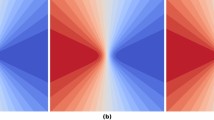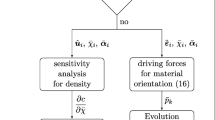Abstract
Nesterov’s 1983 first-order minimization algorithm is equivalent to the numerical solution of a second-order ODE with non-constant damping. It is known that the algorithm can be obtained by time discretization with asynchronous damping, a long-standing technique in computational explicit dynamics. We extend the solution of the ODE to other time discretization algorithms, analyze their properties and provide an engineering interpretation of the process as well as a prototype implementation, addressing the estimation of the relevant parameters in the computational mechanics context. The main result is that a standard Newmark-type time-integration finite element code can be adopted to perform classical optimization in mechanics. Standard FE analysis, sensitivity analysis and optimization are performed in sequence using a typical FE framework. Geometric nonlinearities in the conservative case are addressed by the adjoint-variable method and examples of optimal fiber orientation are shown, exhibiting remarkable advantages with respect to more traditional optimization algorithms.

















Similar content being viewed by others
References
Nesterov Y (1983) A method of solving a convex programming problem with convergence rate \(\bigcirc (1/k^{2})\). Sov Math Dokl 27(2):372–376
Polyak BT (1964) Some methods of speeding up the convergence of iteration methods. USSR Comput Math Math Phys 4(5):1–17
Nesterov Y (2004) Introductory lectures on convex optimization. A basic course, Applied optimization. Kluwer Academic Publishers, Boston
Su W, Boyd S, Candès EJ (2016) A differential equation for modeling Nesterov’s accelerated gradient method: theory and insights. J Mach Learn Res 17:1–43
Hestenes MR, Stiefel E (1952) Methods of conjugate gradients for solving linear systems. J Res Natl Bureau Stand 49:409–436
Karimi S, Vavasis SA (2016) A unified convergence bound for conjugate gradient and accelerated gradient
Drori Y, Taylor AB (2020) Efficient first-order methods for convex minimization: a constructive approach. Math Programm Ser A 184:183–220
Sutskever I, Martens J, Dahl G, Hinton G (2013) On the importance of initialization and momentum in deep learning. In: ICML’13 proceedings of the 30th international conference on machine learning, volume 28, pp III-1139–III-1147
Carlon AG, Dia BM, Espath L, Lopez RH, Tempone R (2020) Nesterov-aided stochastic gradient methods using Laplace approximation for Bayesian design optimization. Comput Method Appl Mech Eng 363:112909
Donoghue BO, Candès E (2015) Adaptive restart for accelerated gradient schemes. Found Comput Math 15:715–732
Schneider M (2017) An fft-based fast gradient method for elastic and inelastic unit cell homogenization problems. Comput Method Appl Mech Eng 315:846–866
Newmark NM (1959) A method of computation for structural dynamics. J Eng Mech Div 85(EM3):67–94
Stegmann J, Lund E (2005) Discrete material optimization of general composite shell structures. Int J Numer Methods Eng 62:2009–2027
Lund E (2018) Discrete material and thickness optimization of laminated composite structures including failure criteria. Strut Multidisc Optim 57:2357–2375
Hvejsel CF, Lund E, Stolpe M (2011) Optimization strategies for discrete multi-material stiffness optimization. Strut Multidisc Optim 44:149–163
Moré JJ, Garbow BS, Hillstrom KE (1981) Testing unconstrained optimization software. ACM Trans Math 7(1):17–41
Fazlyab M, Robey A, Hassani H, Morari M, Pappas G (2019) Efficient and accurate estimation of Lipschitz constants for deep neural networks. In: Wallach H, Larochelle H, Beygelzimer A, dAlché F, Fox E, Garnett R (eds) Advances in neural information processing systems. Curran Associates, Red Hook, pp 11427–11438
Areias P. Simplas. http://www.simplassoftware.com. Portuguese Software Association (ASSOFT) registry number 2281/D/17
Fiacco AV, McCormick GP (1968) Nonlinear programming: sequential unconstrained minimization techniques. Wiley, New York. Reprinted by SIAM Publications in 1990
Apostol TM (1967) Calculus, vol 1, 2nd edn. Wiley, New York, p 443
Belytschko T, Liu WK, Moran B (2000) Nonlinear finite elements for continua and structures. Wiley, New York
Meirovitch L (2001) Fundamentals of vibrations. Mechanical engineering series. McGraw-Hill International, New York, NY
Clough RW, Penzien J (2003) Dynamics of structures, 3rd edn. Computers & Structures Inc, Berkeley, CA
Hughes TJR (2000) The finite element method. Dover Publications. Reprint of Prentice-Hall edition 1987
Gilbert JC, Nocedal J (1992) Global convergence properties of conjugate gradient methods for optimization. SIAM J Optim 2(1):21–42
Nocedal J, Wright S (2006) Numerical optimization. Series operations research. Springer, Berlin
Dai Y, Yuan J, Yuan Y-X (2002) Modified two-point stepsize gradient methods for unconstrained optimization. Comput Optim Appl 22:103–109
Barzilai J, Borwein JM (1988) Two-point step size gradient methods. IMA J Numer Anal 8:141–148
Areias P (2020) Nesterov/Newmark optimizer at IST. https://github.com/PedroAreiasIST/NesterovNewmark
Gavrilovic M, Petrovic R, Siljak D (1963) Adjoint method in sensitivity analysis of optimal systems. J Frankl Inst Eng Appl Math 276(1):26
Byrne CL (2013) Alternating minimization as sequential unconstrained minimization: a survey. J Optim Theory Appl 156:554–566
Wriggers P (2008) Nonlinear finite element methods. Springer, Berlin
Wolfram Research, Inc., Mathematica, Version 9.0, Champaign, IL (2012)
Korelc J (2002) Multi-language and multi-environment generation of nonlinear finite element codes. Eng Comput 18(4):312–327
Sigmund O, Torquato S (1997) Design of materials with extreme thermal expansion using a three-phase topology optimization method. J Mech Phys Solids 45(6):1037–1067
Lund E, Stegmann J (2005) On structural optimization of composite shell structures using a discrete constitutive parametrization. Wind Energy 8:109–124
Polak E, Ribière G (1969) Note sur la convergence de méthodes de directions conjuguées. Rev Française Informat Recherche Opérationelle 1(3):35–43
Acknowledgements
The first author acknowledges the support of FCT, through IDMEC, under LAETA, Project UIDB/50022/2020. The first author would like to thank Professor Leonel Fernandes at IST for the outstanding insight concerning time integration algorithms.
Author information
Authors and Affiliations
Corresponding author
Additional information
Publisher's Note
Springer Nature remains neutral with regard to jurisdictional claims in published maps and institutional affiliations.
Rights and permissions
About this article
Cite this article
Areias, P., Rabczuk, T. An engineering interpretation of Nesterov’s convex minimization algorithm and time integration: application to optimal fiber orientation. Comput Mech 68, 211–227 (2021). https://doi.org/10.1007/s00466-021-02027-z
Received:
Accepted:
Published:
Issue Date:
DOI: https://doi.org/10.1007/s00466-021-02027-z




